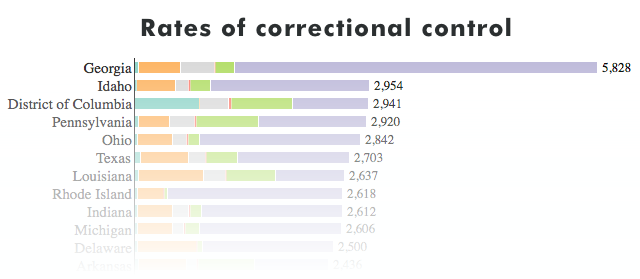New report reveals huge variations in correctional control among states
New report provides big picture of mass incarceration with pie charts for each state and D.C.
June 1, 2016
FOR IMMEDIATE RELEASE: June 1, 2016
Contact:
Bernadette Rabuy
brabuy [at] prisonpolicy.org
Easthampton, MA — Prisons are just one piece of the correctional pie. Some of the seemingly less punitive states are actually the most likely to put their residents under some other form of correctional control, finds a new report by the Prison Policy Initiative.
Correctional Control: Incarceration and supervision by state builds off of the Prison Policy Initiative’s popular report, Mass Incarceration: The Whole Pie, to provide the big picture of mass incarceration. “We often get requests for versions of the pie chart report for each state. Our new report responds to this request with over 100 graphs illustrating the breakdown of the criminal justice system in each state plus D.C.,” said co-author of the report, Peter Wagner. The report also includes an interactive chart that ranks each state and D.C. by rate of total correctional control, which includes incarceration, probation, and parole.
The report uncovers tremendous variations in the forms and rates of criminal justice control:
- Georgia’s rate of probation is more than double every other states’ rate of probation and greater than every other states’ total rates of correctional control.
- Rhode Island and Minnesota, two states with some of the lowest incarceration rates in the country, are among the most punitive when other methods of correctional control are taken into account.
- The capital of the “free world,” D.C., has a higher incarceration rate than any U.S. state and higher than any nation on the planet.
Correctional Control provides another metric for understanding where each state falls within the national landscape of mass incarceration and where state-based advocates may want to focus their attention. The authors of Correctional Control conclude that criminal justice reform strategies should aim to reduce the total number of people under correctional control rather than simply transfer people to other pieces of the correctional pie.
“As the movement to end mass incarceration continues to gain steam, it would be wise to include probation, the leading type of correctional control, in discussions of reform,” explained co-author of the report, Bernadette Rabuy. “Probation has the potential to be a powerful alternative to incarceration but, when used unnecessarily, serves only to widen the net and funnel more people into incarceration.”
The report and the 100+ graphs are available at: http://www.prisonpolicy.org/reports/50statepie.html
-30-




